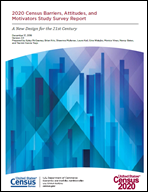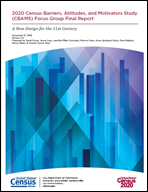2020 Census Barriers, Attitudes, and Motivators Study Survey Report
2020 Census Barriers, Attitudes, and Motivators Study Survey Report
Introduction
The goal of the 2020 Census Integrated Communications Campaign (ICC) is to encourage self-response in the 2020 Census through a research-based communications campaign. Similar to when the Census was preparing for the 2010 enumeration in 2008, in Spring 2018 the Census Bureau’s Communications Research and Analytics Team (CRAT) and Team Y&R conducted a survey called the 2020 Census Barriers, Attitudes, and Motivators Study Survey (2020 CBAMS Survey). The 2020 CBAMS Survey was designed to understand attitudes and behaviors that relate to census participation across demographic characteristics. The survey was designed to provide inputs for two related research projects aimed at informing and enhancing the quality of audience-specific messaging for the 2020 Census communications campaign. The first project, detailed in this report, provides insight into Americans’ attitudes about participation in the census, including how attitudes toward the census vary across certain groups of people. The second project, detailed in a separate forthcoming report, uses survey responses as input to the selection of census mindsets derived through segmentation.
The 2020 CBAMS Survey was administered by mail and internet between February 20, 2018 and April 17, 2018 to a sample of households across all 50 states and the District of Columbia. Adults (i.e., 18 years or older) were eligible to take the survey, which was offered in both English and Spanish. Each household received a prepaid incentive and up to five mailings inviting them to participate in the survey. Approximately 17,500 people responded to the survey, which was then weighted to be representative of all householders in the United States ages 18 and older.
As is detailed in this report, the 2020 CBAMS Survey responses were used to compare barriers, attitudes, knowledge, and motivators related to participation in the 2020 Census across demographic characteristics, with a focus on differences across race, age, gender, education, and country of birth. Specifically, the 2020 CBAMS Survey was used to answer the following rese arch questions:
- Who intends to respond to the 2020 Census?
- Where do gaps in knowledge about the census exist?
- What barriers would potentially prevent people from completing the 2020 Census?
- What would potentially motivate people to complete the 2020 Census?
Throughout the report, the key results of the univariate and bivariate analyses performed to answer these questions are reported in the text and graphs. The research methodology is discussed in greater detail in Section 3, and results are detailed in Section 5. In compliance with U.S. Census Bureau standards, only bivariate relationships that meet a significance level of at least α=0.10 and reflect the largest group differences are included in the text of the report. The point estimates and standard errors for all results, including those not discussed in the text, are available in Appendix A.
A separate forthcoming report details how answers to the 2020 CBAMS Survey were used to identify six mindsets that reflect shared attitudes about, and knowledge and perceptions of, the decennial census. The geographic distribution of respondents with these six mindsets was then used to determine the distribution of mindsets among groupings of census tracts, referred to as segments. Communications professionals will use the mindset composition, geographic segments, and media usage data to create tailored messages and develop a media plan to guide and justify messaging content and media buys.
The 2020 CBAMS Survey was also supplemented with qualitative focus groups designed to help the research team understand the attitudes of small demographic groups or groups that were otherwise difficult to reach with the survey. Although this document does not fully describe the results from the 2020 CBAMS focus groups, which are fully detailed in their own forthcoming report, there are a few notable similarities and differences in the findings from the focus groups and survey. Both the qualitative and quantitative data suggested that the chief barrier to participation in the 2020 Census is a lack of understanding of the purpose and process of the census. The focus groups revealed that a lack of understanding is associated with several negative attitudes toward the census, including apathy, privacy concerns, fear of repercussions, and general distrust of government. In the quantitative survey data, certain demographic characteristics, including low levels of education, being young, and being of racial or ethnic minority groups, are related to low levels of intent to self-respond to the decennial census.
The focus group and survey research also revealed common motivators, or reasons respondents may want to respond to the 2020 Census. The qualitative and quantitative data both indicate that, although there are important differences across demographic groups, funding for public services — such as hospitals, schools, and roads — is a key motivator across groups. Focus groups, in particular, showed that participants might be persuaded of the importance and purpose of the census if they make the connection between completing a census form and the possibility of an increase in funding or support for their community, notably in support of critical community institutions, organizations, and services. In turn, this may boost self-response for the 2020 Census.





